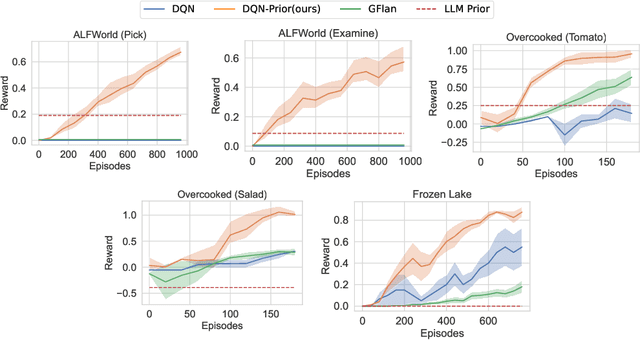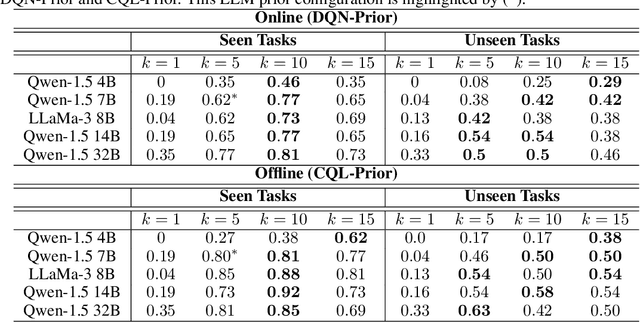Haifeng Zhang
SpatialViz-Bench: Automatically Generated Spatial Visualization Reasoning Tasks for MLLMs
Jul 10, 2025Abstract:Humans can directly imagine and manipulate visual images in their minds, a capability known as spatial visualization. While multi-modal Large Language Models (MLLMs) support imagination-based reasoning, spatial visualization remains insufficiently evaluated, typically embedded within broader mathematical and logical assessments. Existing evaluations often rely on IQ tests or math competitions that may overlap with training data, compromising assessment reliability. To this end, we introduce SpatialViz-Bench, a comprehensive multi-modal benchmark for spatial visualization with 12 tasks across 4 sub-abilities, comprising 1,180 automatically generated problems. Our evaluation of 33 state-of-the-art MLLMs not only reveals wide performance variations and demonstrates the benchmark's strong discriminative power, but also uncovers counter-intuitive findings: models exhibit unexpected behaviors by showing difficulty perception that misaligns with human intuition, displaying dramatic 2D-to-3D performance cliffs, and defaulting to formula derivation despite spatial tasks requiring visualization alone. SpatialVizBench empirically demonstrates that state-of-the-art MLLMs continue to exhibit deficiencies in spatial visualization tasks, thereby addressing a significant lacuna in the field. The benchmark is publicly available.
EconGym: A Scalable AI Testbed with Diverse Economic Tasks
Jun 13, 2025Abstract:Artificial intelligence (AI) has become a powerful tool for economic research, enabling large-scale simulation and policy optimization. However, applying AI effectively requires simulation platforms for scalable training and evaluation-yet existing environments remain limited to simplified, narrowly scoped tasks, falling short of capturing complex economic challenges such as demographic shifts, multi-government coordination, and large-scale agent interactions. To address this gap, we introduce EconGym, a scalable and modular testbed that connects diverse economic tasks with AI algorithms. Grounded in rigorous economic modeling, EconGym implements 11 heterogeneous role types (e.g., households, firms, banks, governments), their interaction mechanisms, and agent models with well-defined observations, actions, and rewards. Users can flexibly compose economic roles with diverse agent algorithms to simulate rich multi-agent trajectories across 25+ economic tasks for AI-driven policy learning and analysis. Experiments show that EconGym supports diverse and cross-domain tasks-such as coordinating fiscal, pension, and monetary policies-and enables benchmarking across AI, economic methods, and hybrids. Results indicate that richer task composition and algorithm diversity expand the policy space, while AI agents guided by classical economic methods perform best in complex settings. EconGym also scales to 10k agents with high realism and efficiency.
Enhancing Efficiency and Propulsion in Bio-mimetic Robotic Fish through End-to-End Deep Reinforcement Learning
Jun 05, 2025Abstract:Aquatic organisms are known for their ability to generate efficient propulsion with low energy expenditure. While existing research has sought to leverage bio-inspired structures to reduce energy costs in underwater robotics, the crucial role of control policies in enhancing efficiency has often been overlooked. In this study, we optimize the motion of a bio-mimetic robotic fish using deep reinforcement learning (DRL) to maximize propulsion efficiency and minimize energy consumption. Our novel DRL approach incorporates extended pressure perception, a transformer model processing sequences of observations, and a policy transfer scheme. Notably, significantly improved training stability and speed within our approach allow for end-to-end training of the robotic fish. This enables agiler responses to hydrodynamic environments and possesses greater optimization potential compared to pre-defined motion pattern controls. Our experiments are conducted on a serially connected rigid robotic fish in a free stream with a Reynolds number of 6000 using computational fluid dynamics (CFD) simulations. The DRL-trained policies yield impressive results, demonstrating both high efficiency and propulsion. The policies also showcase the agent's embodiment, skillfully utilizing its body structure and engaging with surrounding fluid dynamics, as revealed through flow analysis. This study provides valuable insights into the bio-mimetic underwater robots optimization through DRL training, capitalizing on their structural advantages, and ultimately contributing to more efficient underwater propulsion systems.
MF-LLM: Simulating Collective Decision Dynamics via a Mean-Field Large Language Model Framework
Apr 30, 2025Abstract:Simulating collective decision-making involves more than aggregating individual behaviors; it arises from dynamic interactions among individuals. While large language models (LLMs) show promise for social simulation, existing approaches often exhibit deviations from real-world data. To address this gap, we propose the Mean-Field LLM (MF-LLM) framework, which explicitly models the feedback loop between micro-level decisions and macro-level population. MF-LLM alternates between two models: a policy model that generates individual actions based on personal states and group-level information, and a mean field model that updates the population distribution from the latest individual decisions. Together, they produce rollouts that simulate the evolving trajectories of collective decision-making. To better match real-world data, we introduce IB-Tune, a fine-tuning method for LLMs grounded in the information bottleneck principle, which maximizes the relevance of population distributions to future actions while minimizing redundancy with historical data. We evaluate MF-LLM on a real-world social dataset, where it reduces KL divergence to human population distributions by 47 percent over non-mean-field baselines, and enables accurate trend forecasting and intervention planning. It generalizes across seven domains and four LLM backbones, providing a scalable foundation for high-fidelity social simulation.
Refining Interactions: Enhancing Anisotropy in Graph Neural Networks with Language Semantics
Apr 02, 2025Abstract:The integration of Large Language Models (LLMs) with Graph Neural Networks (GNNs) has recently been explored to enhance the capabilities of Text Attribute Graphs (TAGs). Most existing methods feed textual descriptions of the graph structure or neighbouring nodes' text directly into LLMs. However, these approaches often cause LLMs to treat structural information simply as general contextual text, thus limiting their effectiveness in graph-related tasks. In this paper, we introduce LanSAGNN (Language Semantic Anisotropic Graph Neural Network), a framework that extends the concept of anisotropic GNNs to the natural language level. This model leverages LLMs to extract tailor-made semantic information for node pairs, effectively capturing the unique interactions within node relationships. In addition, we propose an efficient dual-layer LLMs finetuning architecture to better align LLMs' outputs with graph tasks. Experimental results demonstrate that LanSAGNN significantly enhances existing LLM-based methods without increasing complexity while also exhibiting strong robustness against interference.
PLM: Efficient Peripheral Language Models Hardware-Co-Designed for Ubiquitous Computing
Mar 15, 2025Abstract:While scaling laws have been continuously validated in large language models (LLMs) with increasing model parameters, the inherent tension between the inference demands of LLMs and the limited resources of edge devices poses a critical challenge to the development of edge intelligence. Recently, numerous small language models have emerged, aiming to distill the capabilities of LLMs into smaller footprints. However, these models often retain the fundamental architectural principles of their larger counterparts, still imposing considerable strain on the storage and bandwidth capacities of edge devices. In this paper, we introduce the PLM, a Peripheral Language Model, developed through a co-design process that jointly optimizes model architecture and edge system constraints. The PLM utilizes a Multi-head Latent Attention mechanism and employs the squared ReLU activation function to encourage sparsity, thereby reducing peak memory footprint during inference. During training, we collect and reorganize open-source datasets, implement a multi-phase training strategy, and empirically investigate the Warmup-Stable-Decay-Constant (WSDC) learning rate scheduler. Additionally, we incorporate Reinforcement Learning from Human Feedback (RLHF) by adopting the ARIES preference learning approach. Following a two-phase SFT process, this method yields performance gains of 2% in general tasks, 9% in the GSM8K task, and 11% in coding tasks. In addition to its novel architecture, evaluation results demonstrate that PLM outperforms existing small language models trained on publicly available data while maintaining the lowest number of activated parameters. Furthermore, deployment across various edge devices, including consumer-grade GPUs, mobile phones, and Raspberry Pis, validates PLM's suitability for peripheral applications. The PLM series models are publicly available at https://github.com/plm-team/PLM.
Vairiational Stochastic Games
Mar 08, 2025Abstract:The Control as Inference (CAI) framework has successfully transformed single-agent reinforcement learning (RL) by reframing control tasks as probabilistic inference problems. However, the extension of CAI to multi-agent, general-sum stochastic games (SGs) remains underexplored, particularly in decentralized settings where agents operate independently without centralized coordination. In this paper, we propose a novel variational inference framework tailored to decentralized multi-agent systems. Our framework addresses the challenges posed by non-stationarity and unaligned agent objectives, proving that the resulting policies form an $\epsilon$-Nash equilibrium. Additionally, we demonstrate theoretical convergence guarantees for the proposed decentralized algorithms. Leveraging this framework, we instantiate multiple algorithms to solve for Nash equilibrium, mean-field Nash equilibrium, and correlated equilibrium, with rigorous theoretical convergence analysis.
ARIES: Stimulating Self-Refinement of Large Language Models by Iterative Preference Optimization
Feb 08, 2025Abstract:A truly intelligent Large Language Model (LLM) should be capable of correcting errors in its responses through external interactions. However, even the most advanced models often face challenges in improving their outputs. In this paper, we explore how to cultivate LLMs with the self-refinement capability through iterative preference training, and how this ability can be leveraged to improve model performance during inference. To this end, we introduce a novel post-training and inference framework, called ARIES: Adaptive Refinement and Iterative Enhancement Structure. This method iteratively performs preference training and self-refinement-based data collection. During training, ARIES strengthen the model's direct question-answering capability while simultaneously unlocking its self-refinement potential. During inference, ARIES harnesses this self-refinement capability to generate a series of progressively refined responses, which are then filtered using either the Reward Model Scoring or a simple yet effective Rule-Based Selection mechanism, specifically tailored to our approach, to construct a dataset for the next round of preference training. Experimental results demonstrate the remarkable performance of ARIES. When applied to the Llama-3.1-8B model and under the self-refinement setting, ARIES surpasses powerful models such as GPT-4o, achieving 62.3% length-controlled (LC) and a 63.3% raw win rates on AlpacaEval 2, outperforming Iterative DPO by 27.8% and 35.5% respectively, as well as a 50.3% win rate on Arena-Hard, surpassing Iterative DPO by 26.6%. Furthermore, ARIES consistently enhances performance on mathematical reasoning tasks like GSM8K and MATH.
A New Approach to Solving SMAC Task: Generating Decision Tree Code from Large Language Models
Oct 21, 2024Abstract:StarCraft Multi-Agent Challenge (SMAC) is one of the most commonly used experimental environments in multi-agent reinforcement learning (MARL), where the specific task is to control a set number of allied units to defeat enemy forces. Traditional MARL algorithms often require interacting with the environment for up to 1 million steps to train a model, and the resulting policies are typically non-interpretable with weak transferability. In this paper, we propose a novel approach to solving SMAC tasks called LLM-SMAC. In our framework, agents leverage large language models (LLMs) to generate decision tree code by providing task descriptions. The model is further self-reflection using feedback from the rewards provided by the environment. We conduct experiments in the SMAC and demonstrate that our method can produce high-quality, interpretable decision trees with minimal environmental exploration. Moreover, these models exhibit strong transferability, successfully applying to similar SMAC environments without modification. We believe this approach offers a new direction for solving decision-making tasks in the future.
Efficient Reinforcement Learning with Large Language Model Priors
Oct 10, 2024



Abstract:In sequential decision-making (SDM) tasks, methods like reinforcement learning (RL) and heuristic search have made notable advances in specific cases. However, they often require extensive exploration and face challenges in generalizing across diverse environments due to their limited grasp of the underlying decision dynamics. In contrast, large language models (LLMs) have recently emerged as powerful general-purpose tools, due to their capacity to maintain vast amounts of domain-specific knowledge. To harness this rich prior knowledge for efficiently solving complex SDM tasks, we propose treating LLMs as prior action distributions and integrating them into RL frameworks through Bayesian inference methods, making use of variational inference and direct posterior sampling. The proposed approaches facilitate the seamless incorporation of fixed LLM priors into both policy-based and value-based RL frameworks. Our experiments show that incorporating LLM-based action priors significantly reduces exploration and optimization complexity, substantially improving sample efficiency compared to traditional RL techniques, e.g., using LLM priors decreases the number of required samples by over 90% in offline learning scenarios.
 Add to Chrome
Add to Chrome Add to Firefox
Add to Firefox Add to Edge
Add to Edge